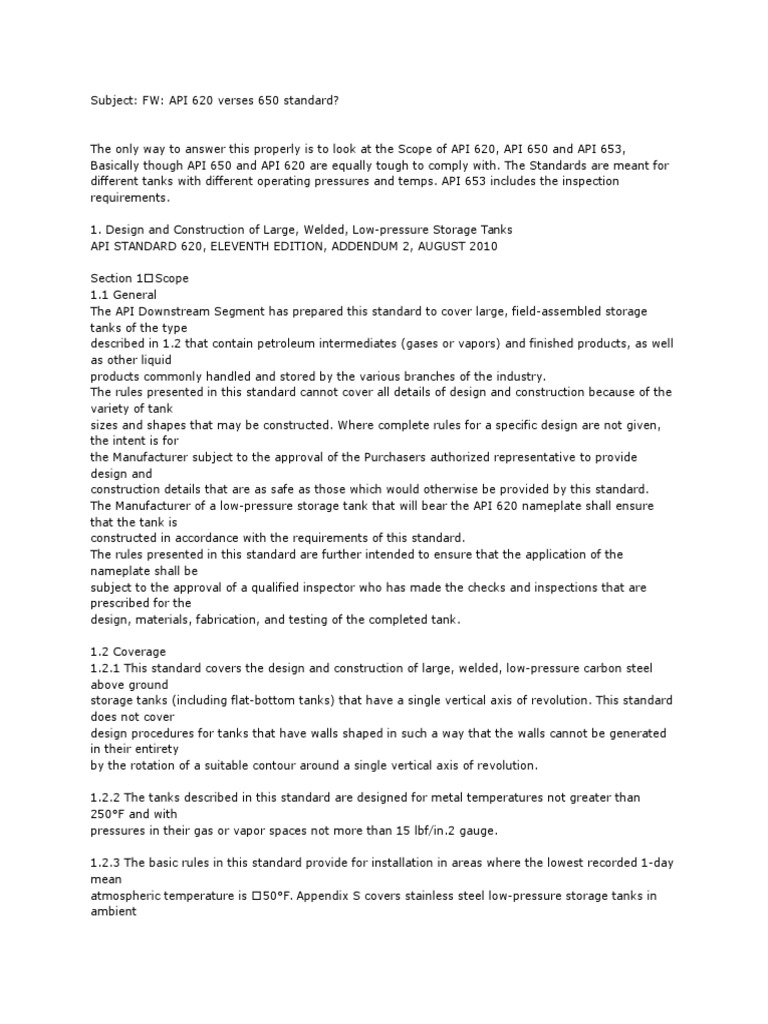
API Standard 620 is applicable to tanks and vessels designed for low-pressure storage, ranging from about 2.5 psig to 15 psig. The provisions of (and changes to) API 620 with regard to leak and spill prevention are essentially the same as those of API 650 and so will not be separately addressed in this paper. After a quick review of this code, it is readily apparent that API 620 is a bit more technologically advanced than its close cousin API 650. The main difference, as mentioned earlier, is that this code has a higher range of design pressure (up to 15 psig). API 620 is different from API 650 in a number of other ways. For example, API 620.
API 620 - Do ALL 'T' Joints Require RT?
API 620 - Do ALL 'T' Joints Require RT?
Api 620 Code

- Www.api.org Stan n and C e Tan DITION OCT nstream Seg e, field-assem 1.2 that cont pors) and fini cts commonly ches of the in cturer of a low I 620 namepl in accordanc rd covers the -pressure carb ding flat-botto of revolution. Edures for tan that the walls he rotation of al axis of revo escribed in th eratures not g their gas or v gauge.
- May 27, 2016 API 620 regulates the design and manufacture of large steel low-pressure storage tanks, usually larger than 300 feet in diameter. By contrast, API Standard 650 is typically used for carbon, stainless steel and aluminium tanks located in terminals, refineries, pipelines and other process facilities.
Api 620 Free Download
Dear Sirs,
We presently have a 316L matl 3/8' wall thk. cyclone separator (F&D head & cone bottom) that the Client has speced out to API 620 Code. The operating temp is 215 deg F and design temp is 300 deg F, op pressure is 3 psig to 5 in. wc vacuum and design pressure is 7.5 psig to 15 in. wc vacuum.
Client test reqs are 10 psig hydro and spot RT w/ 85% jnt efficiency.
API 620 states in 5.26 Radiographic/Ultrasonic Examination
5.26.4.3 (a) When parts of tanks do not require complete examination, circumferential joints in cylindrical or conical surfaces need to be prepared and examined for a distance of only 3 in. on each side of any intersection with a longitudinal joint. All joints in a spherical, torispherical, or ellipsoidal shape or in any other surface or double curvature shall be considered longitudinal joints.
Does this mean that ALL 'T' type joints (circ.-to-long seams) REQUIRE RT?
Appreciate your interpretation and comments,
Robert
We presently have a 316L matl 3/8' wall thk. cyclone separator (F&D head & cone bottom) that the Client has speced out to API 620 Code. The operating temp is 215 deg F and design temp is 300 deg F, op pressure is 3 psig to 5 in. wc vacuum and design pressure is 7.5 psig to 15 in. wc vacuum.
Client test reqs are 10 psig hydro and spot RT w/ 85% jnt efficiency.
API 620 states in 5.26 Radiographic/Ultrasonic Examination
5.26.4.3 (a) When parts of tanks do not require complete examination, circumferential joints in cylindrical or conical surfaces need to be prepared and examined for a distance of only 3 in. on each side of any intersection with a longitudinal joint. All joints in a spherical, torispherical, or ellipsoidal shape or in any other surface or double curvature shall be considered longitudinal joints.
Does this mean that ALL 'T' type joints (circ.-to-long seams) REQUIRE RT?
Appreciate your interpretation and comments,
Robert